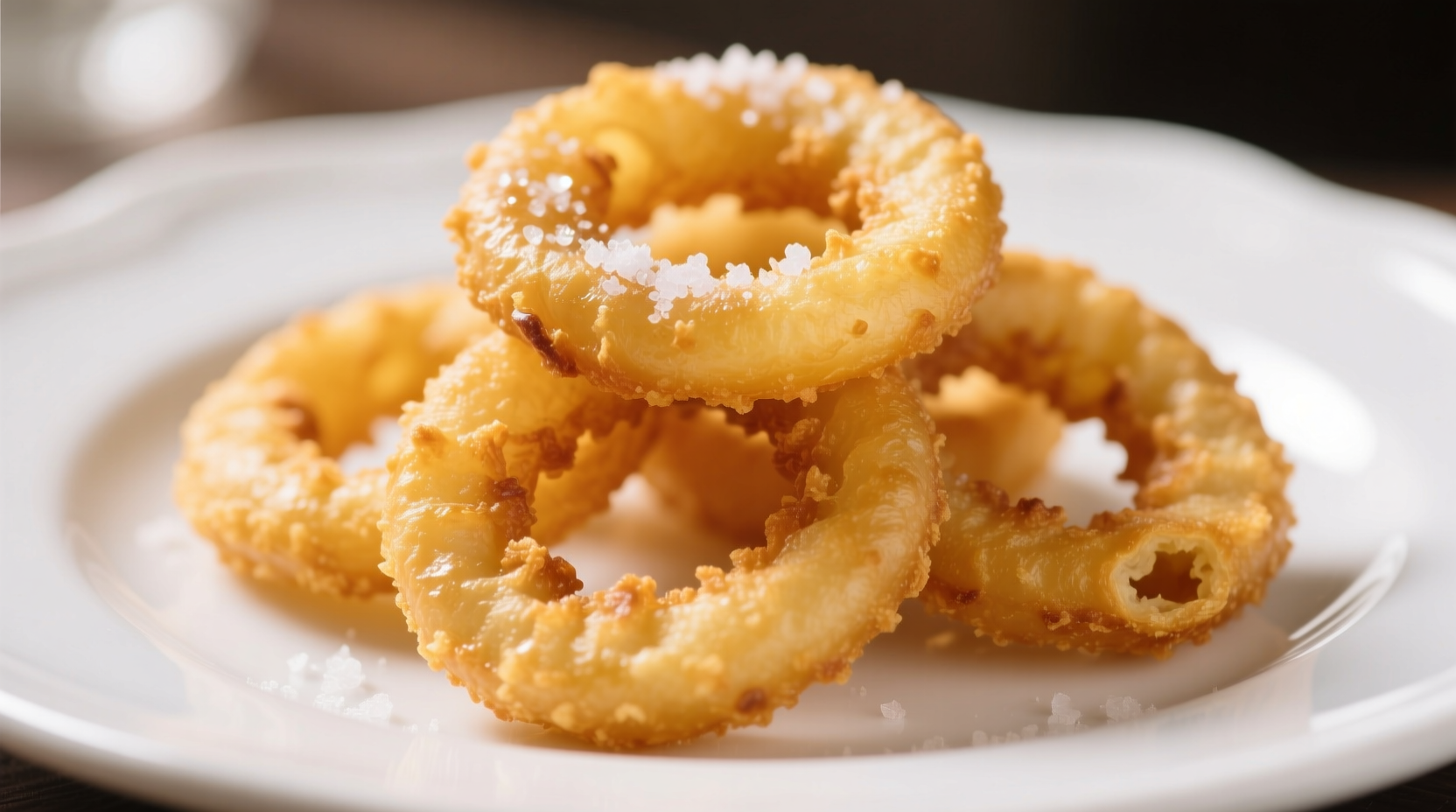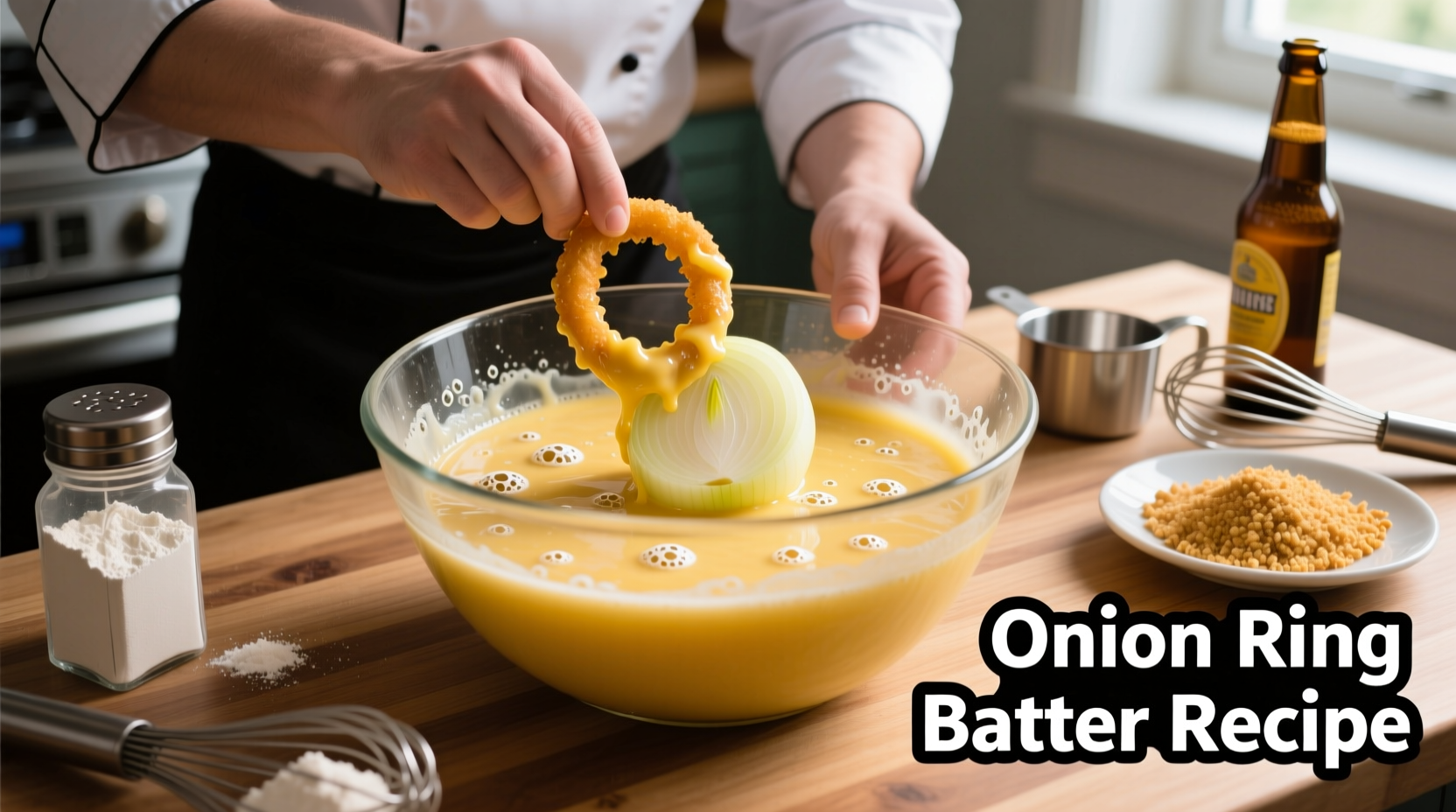The perfect onion ring batter requires just 6 ingredients: 1 cup all-purpose flour, 1 tsp baking powder, 1 tsp paprika, 1/2 tsp garlic powder, 1/4 tsp cayenne (optional), and 1 cup cold beer or buttermilk. Slice onions into 1/2-inch rings, dip in batter, and fry at 375°F (190°C) for 2-3 minutes until golden brown. Key to success: keep batter cold, maintain oil temperature, and don't overcrowd the fryer.
The Science Behind Crispy Onion Ring Batter
Creating the perfect onion ring batter isn't just about following steps—it's understanding the culinary science that transforms simple ingredients into crispy perfection. When you combine cold liquid with flour, you minimize gluten development, which prevents tough, chewy rings. The baking powder creates tiny air pockets as it reacts with liquid, giving that light, airy texture professional kitchens achieve.
According to the USDA Food Safety and Inspection Service, maintaining proper oil temperature between 350-375°F (175-190°C) is critical—not just for texture, but for food safety. Oil that's too cool causes excessive oil absorption (making rings greasy), while oil that's too hot burns the exterior before the interior cooks.
| Ingredient | Function | Substitution Options |
|---|---|---|
| Cold beer or buttermilk | Creates carbonation for lightness; acidity tenderizes | Sparkling water + 1 tbsp vinegar |
| Baking powder | Provides lift and crispness | 1/2 tsp baking soda + 1/2 tsp cream of tartar |
| All-purpose flour | Creates structure without toughness | Rice flour for extra crispness |
Step-by-Step Preparation Guide
Preparation takes 15 minutes, cooking 10 minutes—total time under 30 minutes for restaurant-quality results.
Preparing Your Onions
Select sweet Vidalia or Walla Walla onions for optimal flavor and ring formation. Using a sharp knife, cut crosswise into 1/2-inch thick slices, then carefully separate into individual rings. Soak in ice water for 10 minutes—this firms the onion structure and reduces sulfur compounds that cause bitterness.

Mixing the Perfect Batter
The secret to non-greasy onion rings lies in proper batter consistency. In a large bowl, whisk together:
- 1 cup all-purpose flour
- 1 teaspoon baking powder
- 1 teaspoon paprika
- 1/2 teaspoon garlic powder
- 1/4 teaspoon cayenne pepper (optional for heat)
- 1/2 teaspoon salt
Gradually whisk in 1 cup cold beer or buttermilk until just combined—do not overmix. Lumps are acceptable; smooth batter creates dense, heavy coating. For extra-crispy results, refrigerate batter for 30 minutes before using.
Frying Technique for Maximum Crispness
Heat neutral oil (like peanut or canola) to 375°F (190°C) in a deep fryer or heavy pot. Test temperature with a small drop of batter—it should sizzle immediately and rise to the surface.
Dip onion rings in batter, allowing excess to drip off. Fry in small batches (4-5 rings at a time) for 2-3 minutes until deep golden brown. Use a spider strainer to remove rings, shaking gently to remove excess oil. Drain on wire rack (not paper towels) to maintain crispness on all sides.
Troubleshooting Common Problems
Batter falls off during frying: Onion rings weren't properly dried after soaking, or batter was too thin. Pat rings thoroughly with paper towels before dipping.
Rings are soggy: Oil temperature dropped below 350°F. Use a thermometer and allow oil to return to proper temperature between batches. Overcrowding the fryer is the most common cause.
Uneven browning: Inconsistent oil temperature or batter application. Maintain steady heat and ensure even coating on all sides of the onion ring.
Pro Tips for Restaurant-Quality Results
Professional chefs use a double-fry technique for ultimate crispness: first at 325°F (160°C) for 1 minute to set the batter, then at 375°F (190°C) for 1-2 minutes to achieve golden color. This method creates a moisture barrier that prevents oil absorption.
For gluten-free options, replace all-purpose flour with a 50/50 blend of rice flour and cornstarch. The cornstarch provides that signature crunch while rice flour mimics traditional texture.
Season immediately after frying with fine sea salt while rings are still hot—this ensures perfect adhesion. Serve with classic dipping sauces like buttermilk ranch or spicy aioli for the complete experience.
Frequently Asked Questions
Can I bake onion rings instead of frying?
Yes, but results differ significantly. For baked rings, coat in batter, spray lightly with oil, and bake at 425°F (220°C) on a wire rack for 15-18 minutes, flipping halfway. Baked rings won't achieve the same crispness as fried, but using panko breadcrumbs in the batter improves texture.
Why does my batter separate from the onion?
This happens when onions aren't properly dried before dipping or when batter is too thin. Always pat onion rings thoroughly with paper towels after soaking. For better adhesion, dip rings in flour first, then batter, creating a 'glue layer' that prevents separation during frying.
How do I keep onion rings crispy after cooking?
Drain on a wire rack instead of paper towels to prevent steam buildup. For best results, serve immediately. If reheating, use an air fryer at 375°F (190°C) for 3-4 minutes—this restores crispness better than microwave or conventional oven methods.
What's the best onion variety for onion rings?
Sweet onions like Vidalia, Walla Walla, or Texas Sweet work best due to their high sugar content and mild flavor. These varieties form perfect rings and caramelize beautifully when fried. Avoid pungent yellow onions which can become bitter when cooked.











 浙公网安备
33010002000092号
浙公网安备
33010002000092号 浙B2-20120091-4
浙B2-20120091-4